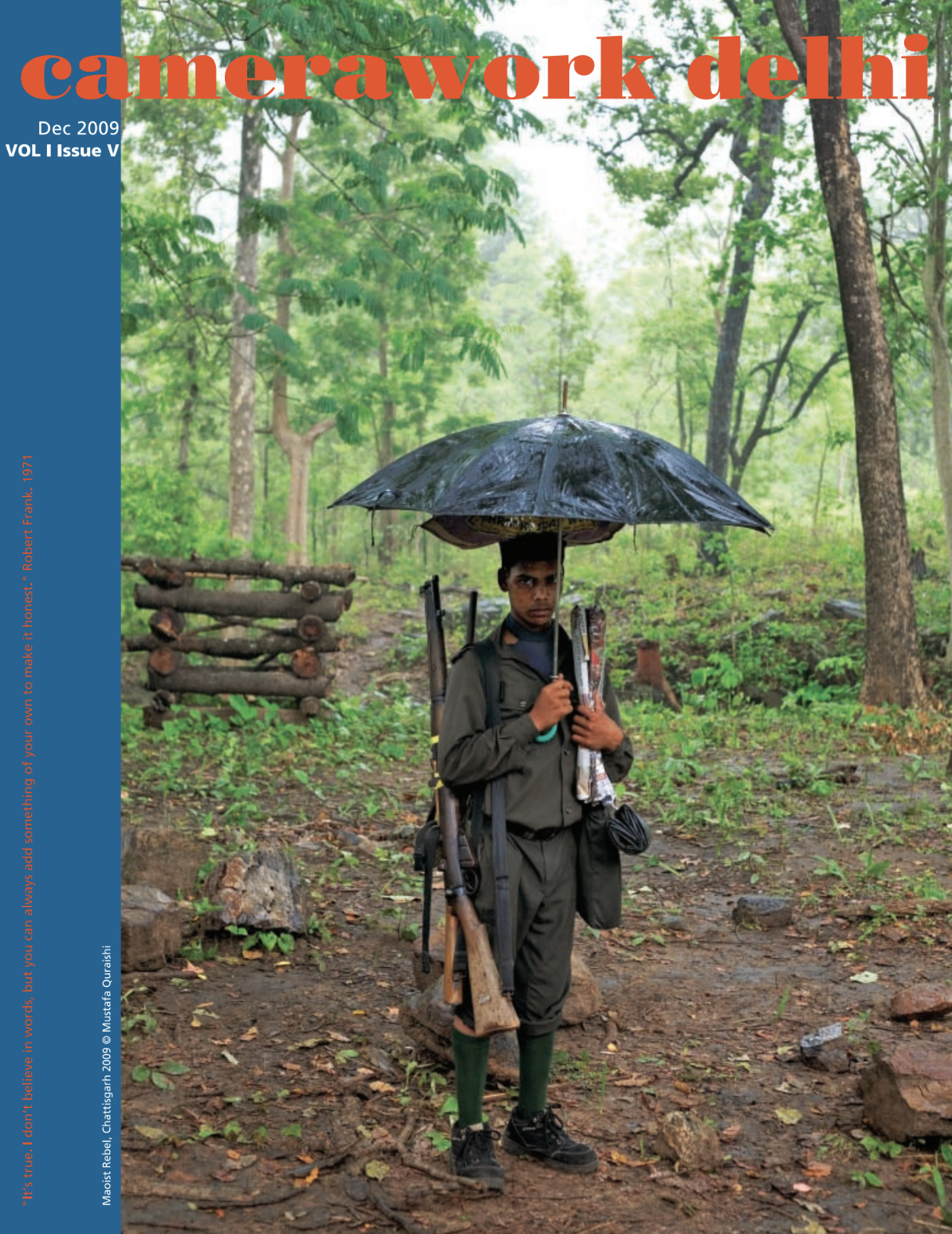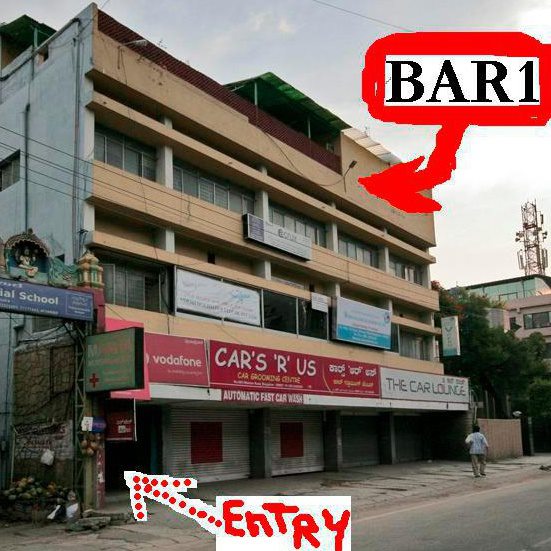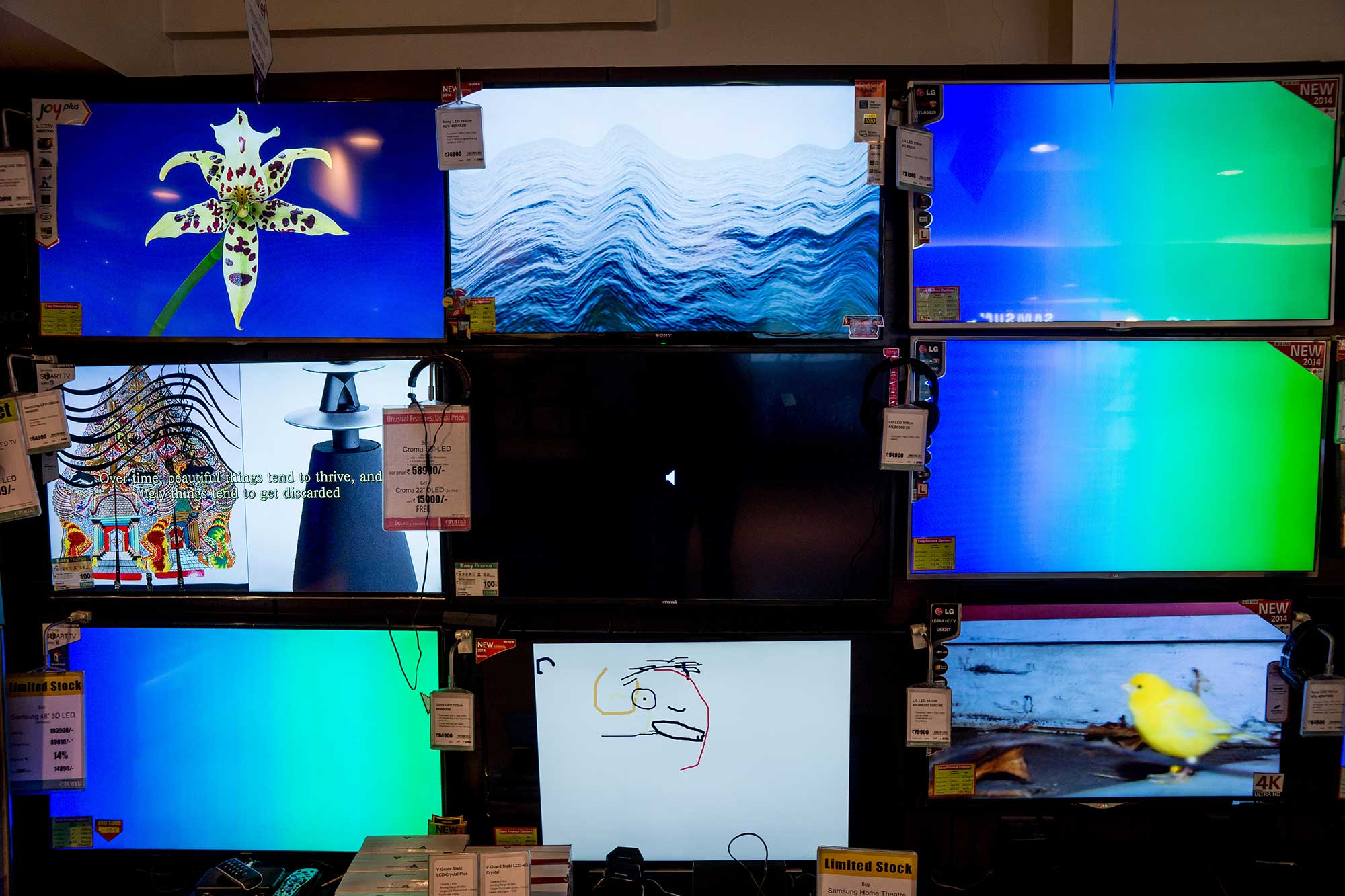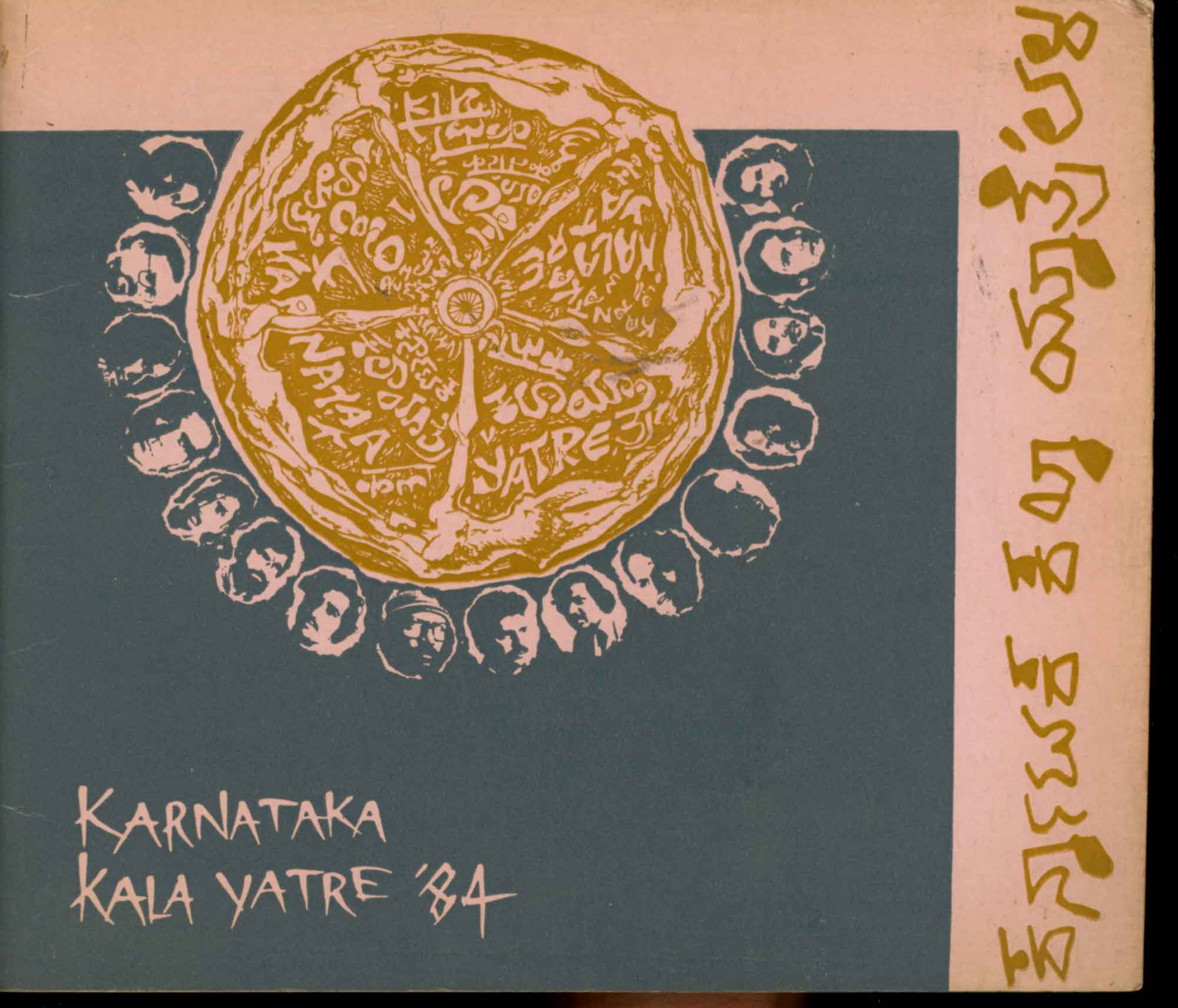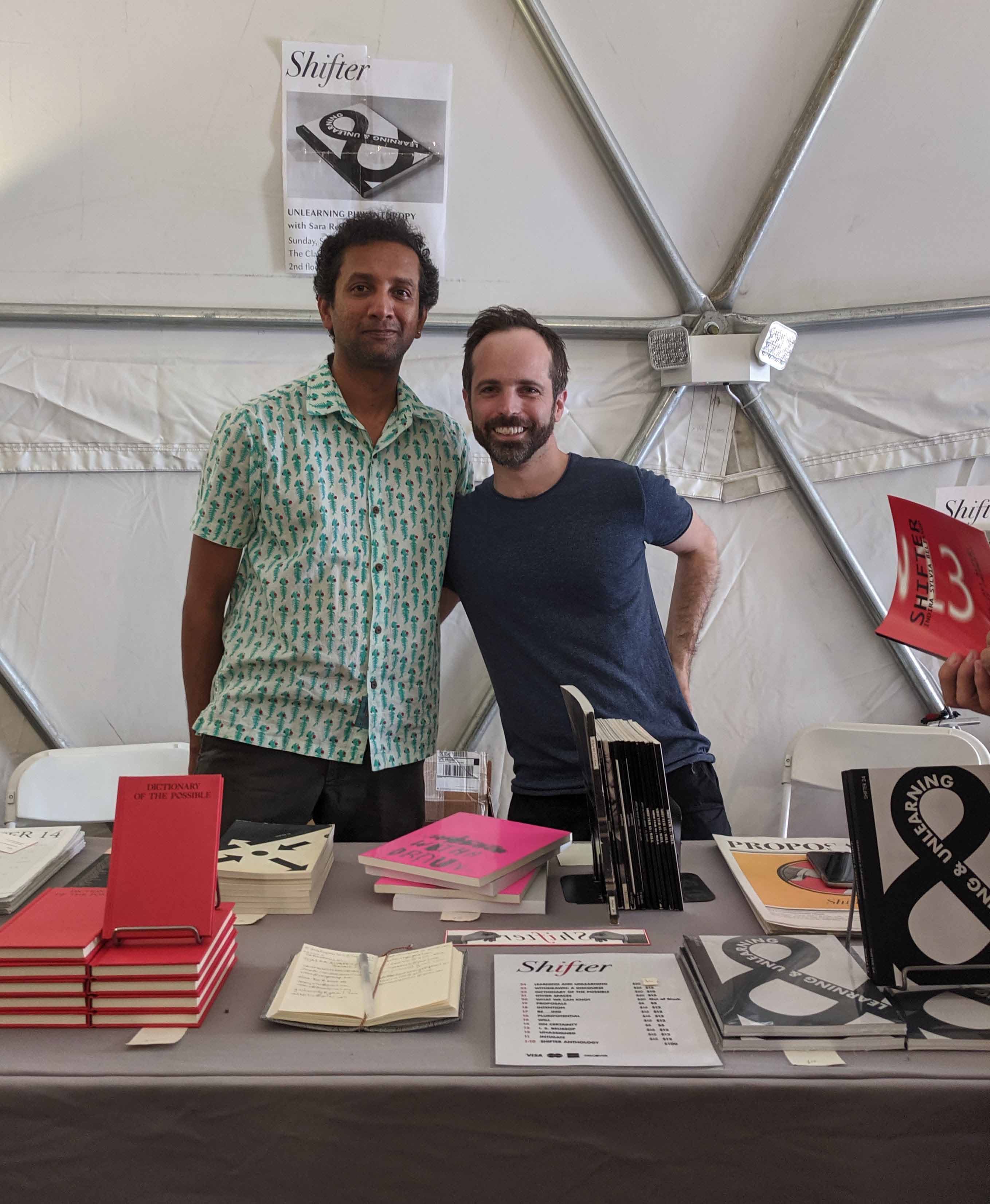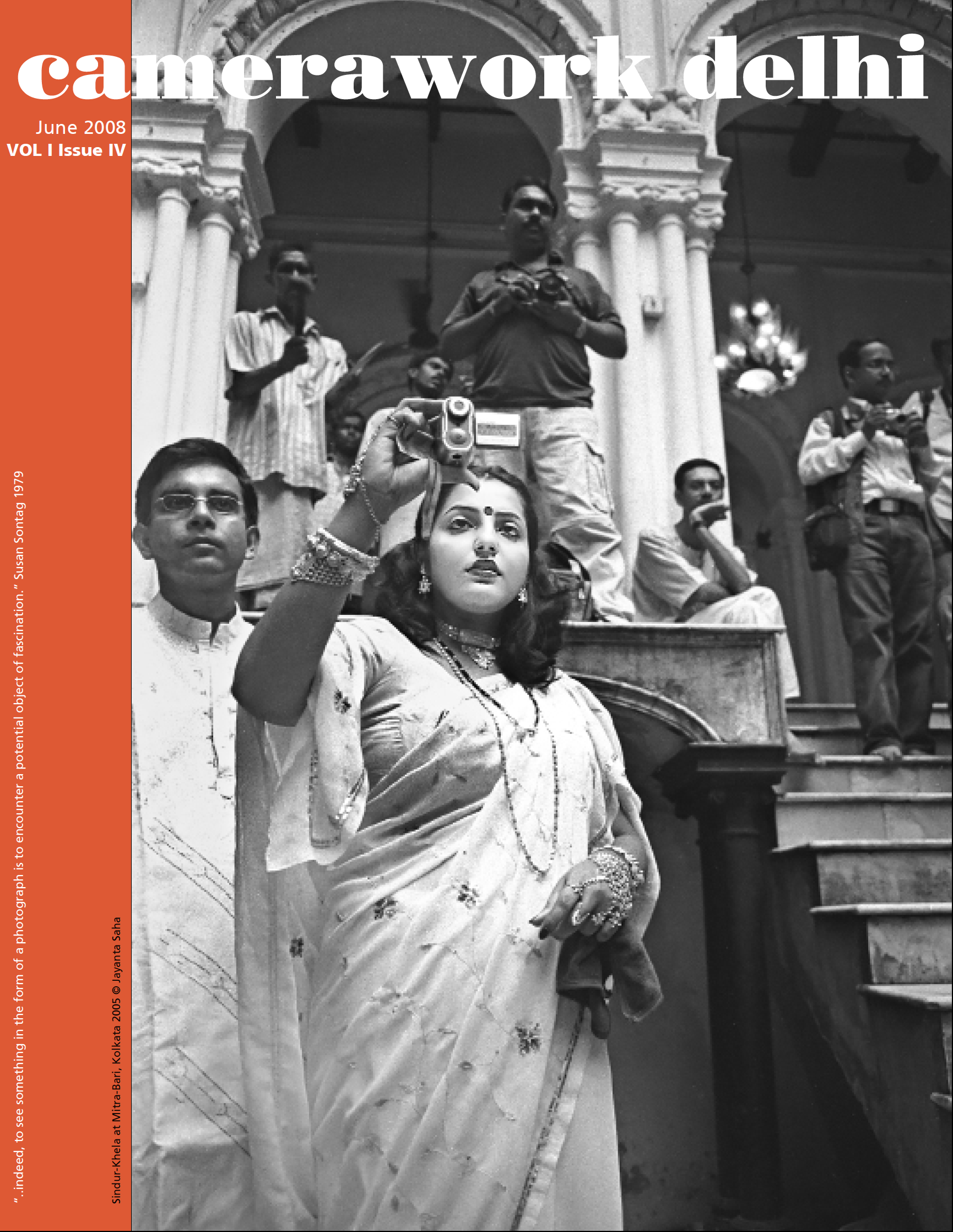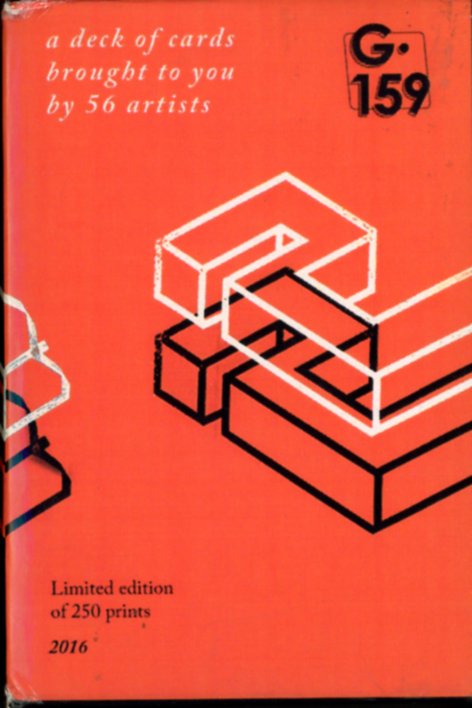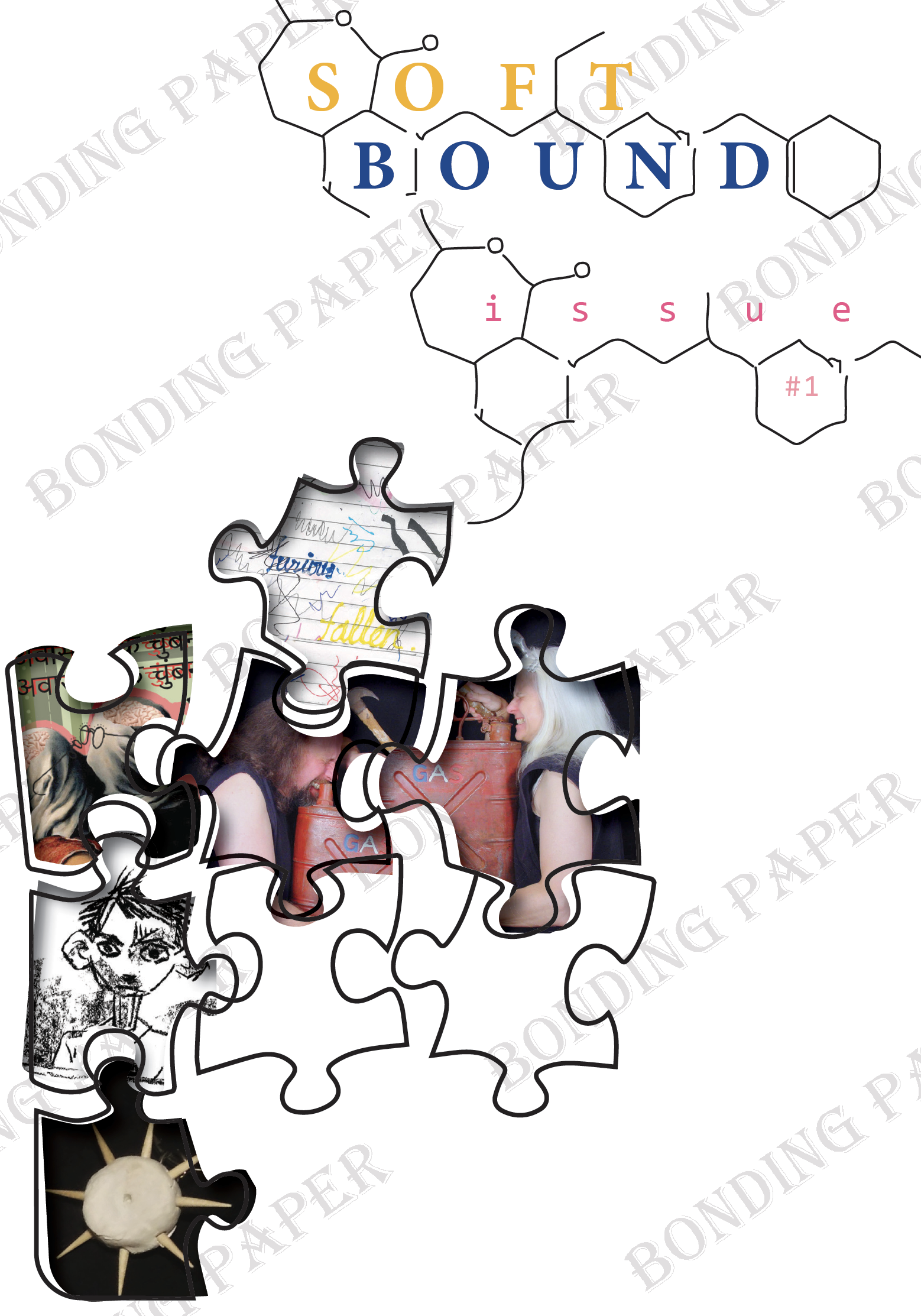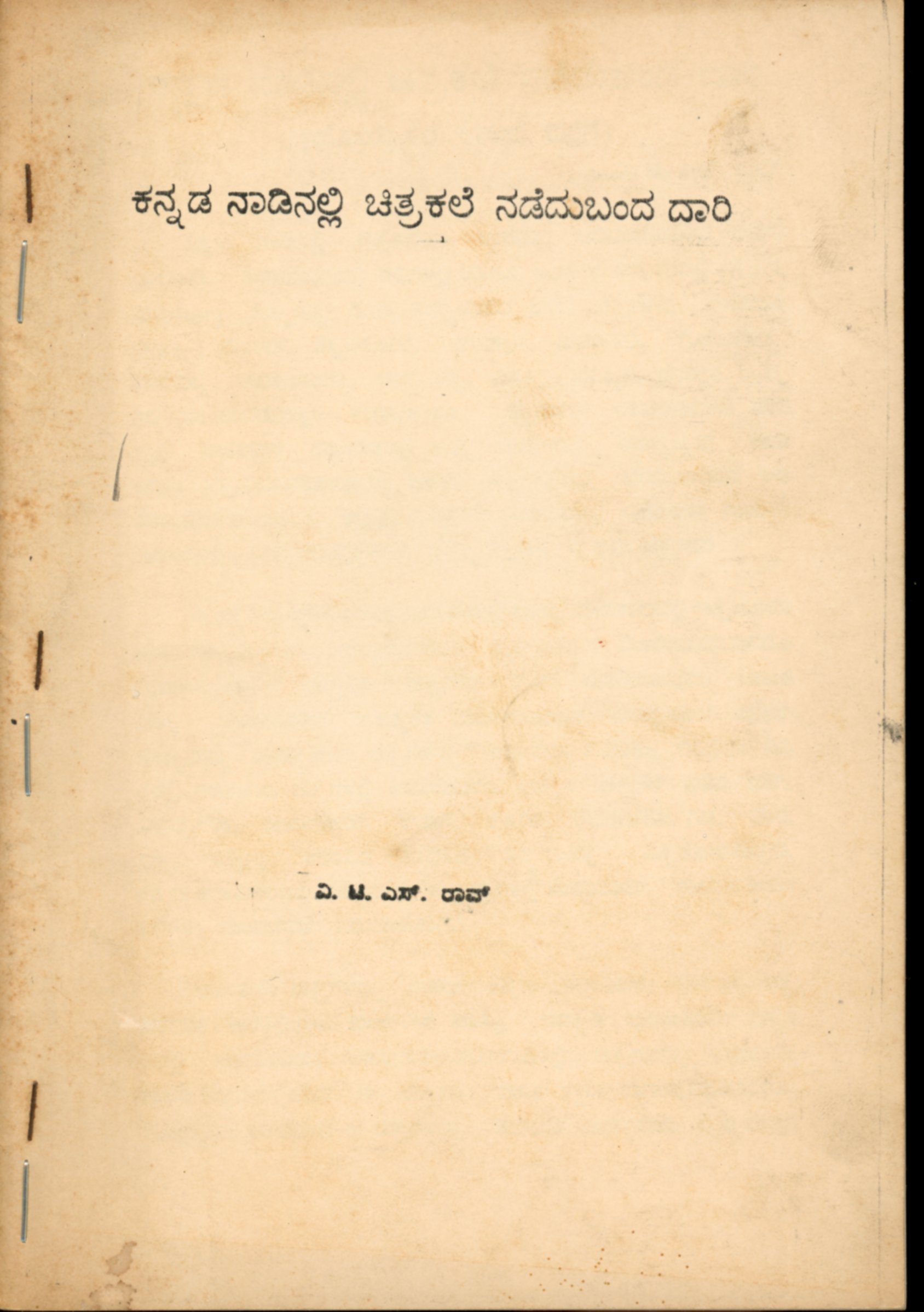Camerawork
Delhi, 2006–2011
Siddhi Bhandari
Camerawork Delhi, a photography magazine dedicated to contemporary practices, was in print from 2006 to 2011, edited by Gauri Gill, Sunil Gupta, and Radhika Singh. In her study, Siddhi Bhandari highlights the significance of this publication within its historical moment, drawing on archival material and interviews with the editors to examine its context and impact. She analyses the term camerawork as a network of people that forms around the technicalities of the camera and the practice of photography.
Siddhi Bhandari
Camerawork Delhi, a photography magazine dedicated to contemporary practices, was in print from 2006 to 2011, edited by Gauri Gill, Sunil Gupta, and Radhika Singh. In her study, Siddhi Bhandari highlights the significance of this publication within its historical moment, drawing on archival material and interviews with the editors to examine its context and impact. She analyses the term camerawork as a network of people that forms around the technicalities of the camera and the practice of photography.
Artist-led Publication And Reading
Platforms In India
Allan Parker
Allan Parker writes about independent publication houses and publishing practices in the arts in India. The essay highlights works of Reliable Copy by Nihaal Faizal and Sarasija Subramanian, Editions JOJO by Kaamna Patel, Kānike Studio by Vivek Muthuramalingam, Indu Antony and Krishanu Chatterjee, Offset Projects by Anshika Varma and Atelier Prati by Jayasimha Chandrashekhar and S Basavachar. The essay situates the book as a cultural and artistic object examining its place within the frameworks of economics, creative practice, and materialities of independent initiatives by artists.
Allan Parker
Allan Parker writes about independent publication houses and publishing practices in the arts in India. The essay highlights works of Reliable Copy by Nihaal Faizal and Sarasija Subramanian, Editions JOJO by Kaamna Patel, Kānike Studio by Vivek Muthuramalingam, Indu Antony and Krishanu Chatterjee, Offset Projects by Anshika Varma and Atelier Prati by Jayasimha Chandrashekhar and S Basavachar. The essay situates the book as a cultural and artistic object examining its place within the frameworks of economics, creative practice, and materialities of independent initiatives by artists.
An Eye for the In-Between Spaces
Joshua Muyiwa
Joshua Muyiwa looks at the unique landscape of independent art initiatives in Bangalore that have now come to define the city. Tracing this history from the late 90s, he traces how models to share art, ideas, skills, and works—driven by a certain entrepreneurial spirit—have forged paths for other ways of being in the arts. The essay dwells on questions around curatorial visions, sustainability, and the resources of such initiatives along with their artistic practice.
Joshua Muyiwa
Joshua Muyiwa looks at the unique landscape of independent art initiatives in Bangalore that have now come to define the city. Tracing this history from the late 90s, he traces how models to share art, ideas, skills, and works—driven by a certain entrepreneurial spirit—have forged paths for other ways of being in the arts. The essay dwells on questions around curatorial visions, sustainability, and the resources of such initiatives along with their artistic practice.
Sides and
Accompaniments: The Pagal
Canvas Backyard
Stuti Bhavsar
Stuti Bhavsar explores the themes of the institution and the alternate; the artist and the cultural worker; and art and commerce—not confined to their binaristic underpinnings, but as sites of relationalities, which though often uncomfortable, are central to the workings of the art world. Keeping Pagal Canvas Backyard, an independent print- and service-based initiative in Bangalore, as the focus, the essay hints at spaces of negotiations in the arts.
Stuti Bhavsar
Stuti Bhavsar explores the themes of the institution and the alternate; the artist and the cultural worker; and art and commerce—not confined to their binaristic underpinnings, but as sites of relationalities, which though often uncomfortable, are central to the workings of the art world. Keeping Pagal Canvas Backyard, an independent print- and service-based initiative in Bangalore, as the focus, the essay hints at spaces of negotiations in the arts.
Beyond the Social Turn: The Dialogue Interactive Artists Association (DIAA)
Arushi Vats
Beyond the Social Turn, considers the frameworks of practice developed by the Dialogu Interactive Artists Association (DIAA), based in Bastar, India as provocations for contending with dominant notions of collaborative, socially-engaged or artist-led group initiatives. Focusing on select projects such as Nalpar, Pilla Gudis and Samvad, the essay dwells on radical possibilitie for agency in artmaking and its revisionist implications for methodologies of art criticism and discursive exchange.
Arushi Vats
Beyond the Social Turn, considers the frameworks of practice developed by the Dialogu Interactive Artists Association (DIAA), based in Bastar, India as provocations for contending with dominant notions of collaborative, socially-engaged or artist-led group initiatives. Focusing on select projects such as Nalpar, Pilla Gudis and Samvad, the essay dwells on radical possibilitie for agency in artmaking and its revisionist implications for methodologies of art criticism and discursive exchange.
Models for a Suburban Art Scene—Yelahanka’s Transient Art Spaces
Anisha Baid
Anisha Baid, writing about the arts scene in Yelahanka, a suburb of Bangalore, contemplates the burgeoning arts initiatives in the area. Notably, a significant proportion of these initiatives are spearheaded by students living in the area and remain transient, tied to the duration of their academic pursuits. Anisha delves into the intricate interplay between a suburb nestled within a metropolitan city, the influx of art students therein, and the realm of arts education as the setting for one of the most experimental DIY art spaces in the country.
Anisha Baid
Anisha Baid, writing about the arts scene in Yelahanka, a suburb of Bangalore, contemplates the burgeoning arts initiatives in the area. Notably, a significant proportion of these initiatives are spearheaded by students living in the area and remain transient, tied to the duration of their academic pursuits. Anisha delves into the intricate interplay between a suburb nestled within a metropolitan city, the influx of art students therein, and the realm of arts education as the setting for one of the most experimental DIY art spaces in the country.
Placemaking without Borders (Part 1):
Framing the Artistic Exchange between Bangalore and Aarau amid India’s Post-liberalization Internationalism
Shramona Maiti
In 1997, an artist residency exchange began between Bangalore, India and Aarau, Switzerland. In this two-part essay, Shramona Maiti explores the dynamics of art and cultural exchange using the Bangalore–Aarau exchange as a case study, shedding light on the influence of internationalism and artist-led initiatives in post-1990s India. She interviewed artists associated with this exchange and also gathered archival materials to weave this narrative of independent initiatives in India post liberalization and just before the art boom hit the country.
Framing the Artistic Exchange between Bangalore and Aarau amid India’s Post-liberalization Internationalism
Shramona Maiti
In 1997, an artist residency exchange began between Bangalore, India and Aarau, Switzerland. In this two-part essay, Shramona Maiti explores the dynamics of art and cultural exchange using the Bangalore–Aarau exchange as a case study, shedding light on the influence of internationalism and artist-led initiatives in post-1990s India. She interviewed artists associated with this exchange and also gathered archival materials to weave this narrative of independent initiatives in India post liberalization and just before the art boom hit the country.
The Aarau–Bangalore Exchange (Part 2):
Dynamics of Self-Organization in the Making of Global Art Spaces
Shramona Maiti
In 1997, an artist residency exchange began between Bangalore, India and Aarau, Switzerland. In this two-part essay, Shramona Maiti explores the dynamics of art and cultural exchange using the Bangalore–Aarau exchange as a case study, shedding light on the influence of internationalism and artist-led initiatives in post-1990s India. She interviewed artists associated with this exchange and also gathered archival materials to weave this narrative of independent initiatives in India post liberalization and just before the art boom hit the country.
Maiti writes, “Together, the two articles highlight the significance of the Aarau–Bangalore artistic exchange within the critical history of global art, emphasizing how artist-led placemaking played a role in overcoming cultural barriers in the post-90s art world. It thus aims to offer insights into the complex interplay of ideologies, self-organization, and the making of a global art space.”
Dynamics of Self-Organization in the Making of Global Art Spaces
Shramona Maiti
In 1997, an artist residency exchange began between Bangalore, India and Aarau, Switzerland. In this two-part essay, Shramona Maiti explores the dynamics of art and cultural exchange using the Bangalore–Aarau exchange as a case study, shedding light on the influence of internationalism and artist-led initiatives in post-1990s India. She interviewed artists associated with this exchange and also gathered archival materials to weave this narrative of independent initiatives in India post liberalization and just before the art boom hit the country.
Maiti writes, “Together, the two articles highlight the significance of the Aarau–Bangalore artistic exchange within the critical history of global art, emphasizing how artist-led placemaking played a role in overcoming cultural barriers in the post-90s art world. It thus aims to offer insights into the complex interplay of ideologies, self-organization, and the making of a global art space.”
Fortuitous Associations and Kin Networks
Marialaura Ghidini
Marialaura Ghidini, an Italian curator who has lived and worked in India for some years, writes about her curatorial work at the intersections of art, technology, and society, particularly with reference to her enduring connection with the city of Bangalore in this regard. Her essay describes the various collaborations that came about to envision some iconic projects such as The C(h)roma Show, #exstrange, Silicon Plateau, Curating on the Web, etc.
Marialaura Ghidini
Marialaura Ghidini, an Italian curator who has lived and worked in India for some years, writes about her curatorial work at the intersections of art, technology, and society, particularly with reference to her enduring connection with the city of Bangalore in this regard. Her essay describes the various collaborations that came about to envision some iconic projects such as The C(h)roma Show, #exstrange, Silicon Plateau, Curating on the Web, etc.
Tracing 50 Years of Jadavpur University Photographic Club
[1967 - 2017]
Sourav Sill
Sourav Sil’s long-term research on the Jadavpur University Photographic Club looks at the archive of the catalogs/souvenirs published by the club to trace its photographic interests, themes, practices, and use of technology over time. He considers the club’s photographic engagements and limitations within the social-cultural context of the university vis-à-vis the position of the club as an “independent” space operating within a formal institution.
[1967 - 2017]
Sourav Sill
Sourav Sil’s long-term research on the Jadavpur University Photographic Club looks at the archive of the catalogs/souvenirs published by the club to trace its photographic interests, themes, practices, and use of technology over time. He considers the club’s photographic engagements and limitations within the social-cultural context of the university vis-à-vis the position of the club as an “independent” space operating within a formal institution.
Karnataka Kalamela: Its Origins and Impact on the Art Scene in Karnataka
Ravi Kumar Kashi
Ravikumar Kashi gathers an extensive archive of the Karnataka Kalamela catalogs/souvenirs, Kala Mahotsava’s invites, and Kala Yatre catalogs and closely traces how the coming together of artists to create art festivals independently in Karnataka before the 1990s brought about significant changes in the art world. He attempts to trace the cultural-educational contexts of the art world as it was then and how this led to the building up of a collective energy within the Karnataka artist community to create and sustain spaces to showcase and talk about art.
Ravi Kumar Kashi
Ravikumar Kashi gathers an extensive archive of the Karnataka Kalamela catalogs/souvenirs, Kala Mahotsava’s invites, and Kala Yatre catalogs and closely traces how the coming together of artists to create art festivals independently in Karnataka before the 1990s brought about significant changes in the art world. He attempts to trace the cultural-educational contexts of the art world as it was then and how this led to the building up of a collective energy within the Karnataka artist community to create and sustain spaces to showcase and talk about art.
Made-to-Order Art on Main Street
Aileen Blaney
Aileen Blaney visits Pune’s Kholsa Galli framers to explore the world of art that fits all budgets. Looking away from the gallery-centric art world that mostly drives the art market, the essay explores customer-centric, made-to-order art on the street where every image from Van Gogh to gods printed or painted on different materials are up for grabs. This is an economy of access, and originality isn’t the currency.
Aileen Blaney visits Pune’s Kholsa Galli framers to explore the world of art that fits all budgets. Looking away from the gallery-centric art world that mostly drives the art market, the essay explores customer-centric, made-to-order art on the street where every image from Van Gogh to gods printed or painted on different materials are up for grabs. This is an economy of access, and originality isn’t the currency.
Conditions of Production: Looking at Independent Printmaking Studios in Baroda
Stuti Bhavsar
Stuti Bhavsar writes about the complex relationships between the multiple roles one takes on in the world of printmaking—that of the technician, the teacher, the artist, etc. Focusing on a few printmaking studios in Baroda, her essay focuses on the structures and impetuses that govern print studios, their economic models, and the porous relational interactions between space, material, and titles, which are not always in harmony.
Stuti Bhavsar
Stuti Bhavsar writes about the complex relationships between the multiple roles one takes on in the world of printmaking—that of the technician, the teacher, the artist, etc. Focusing on a few printmaking studios in Baroda, her essay focuses on the structures and impetuses that govern print studios, their economic models, and the porous relational interactions between space, material, and titles, which are not always in harmony.
1Footnote
Chinar Shah
Chinar Shah’s editorial reflects on ways of defining self-organizing in India through the use of common phrases such as independent, artist-led, DIY, DIT, alternative, and more.
She writes, “In this one year, I have read excellent critiques of many terms that are easily available to define self-organizing in the arts. I have read counterarguments and some more. I have spoken to countless artists and cultural workers in India to understand how they define their own work and practices. I find myself torn between nuanced vocabularies—part of me wants to hold on to them and part of me wants to just throw them in a garbage can.”
Chinar Shah
Chinar Shah’s editorial reflects on ways of defining self-organizing in India through the use of common phrases such as independent, artist-led, DIY, DIT, alternative, and more.
She writes, “In this one year, I have read excellent critiques of many terms that are easily available to define self-organizing in the arts. I have read counterarguments and some more. I have spoken to countless artists and cultural workers in India to understand how they define their own work and practices. I find myself torn between nuanced vocabularies—part of me wants to hold on to them and part of me wants to just throw them in a garbage can.”
Each File is a Person (Part I)
Samira Bose
An Interview with T. Jayashree and Siddarth Ganesh from the QAMRA (Queer Archive of Memory, Reflection, and Activism) Archival Project at NLSIU, Bengaluru.
In the first segment of a two-part interview, Samira Bose speaks with T. Jayashree and Siddarth Ganesh from QAMRA about self-organizing an independent archive, the complication of categorizing archival materials, and their dialogue with other like-minded projects across the global south.
Samira Bose
An Interview with T. Jayashree and Siddarth Ganesh from the QAMRA (Queer Archive of Memory, Reflection, and Activism) Archival Project at NLSIU, Bengaluru.
In the first segment of a two-part interview, Samira Bose speaks with T. Jayashree and Siddarth Ganesh from QAMRA about self-organizing an independent archive, the complication of categorizing archival materials, and their dialogue with other like-minded projects across the global south.
Each File is a Person (Part II)
Samira Bose
An Interview with T. Jayashree and Siddarth Ganesh from the QAMRA (Queer Archive of Memory, Reflection, and Activism) Archival Project at NLSIU, Bengaluru.
In the first segment of a two-part interview, Samira Bose speaks with T. Jayashree and Siddarth Ganesh from QAMRA about self-organizing an independent archive, the complication of categorizing archival materials, and their dialogue with other like-minded projects across the global south.
In the second part, they share about intergenerational conversations, attuning to affect and feeling in archives, and their shift in 2021 from a residential space to the campus at the National Law School of India University, Bengaluru.
Samira Bose
An Interview with T. Jayashree and Siddarth Ganesh from the QAMRA (Queer Archive of Memory, Reflection, and Activism) Archival Project at NLSIU, Bengaluru.
In the first segment of a two-part interview, Samira Bose speaks with T. Jayashree and Siddarth Ganesh from QAMRA about self-organizing an independent archive, the complication of categorizing archival materials, and their dialogue with other like-minded projects across the global south.
In the second part, they share about intergenerational conversations, attuning to affect and feeling in archives, and their shift in 2021 from a residential space to the campus at the National Law School of India University, Bengaluru.
Interview with Sreshta Rit Premnath
Nihaal Faizal
Nihaal Faizal interviews artist Sreshta Rit Premnath, the founder of Shifter magazine, started in 2004. This conversation took place when Shifter was coming to a close and Sreshta reflects on his journey with this project.
Nihaal Faizal
Nihaal Faizal interviews artist Sreshta Rit Premnath, the founder of Shifter magazine, started in 2004. This conversation took place when Shifter was coming to a close and Sreshta reflects on his journey with this project.
Interview with Suman Gopinath and Edgar Demello
Nihaal Faizal
Nihaal Faizal speaks to curator Suman Gopinath and architect Edgar Demello about CoLAB, a curatorial space for art and architecture in Bangalore. They talk about CoLAB’s inception as a space that morphed from other such practices and interests of the organizers and also discuss its lifespan in the city through various shows, projects, and curations.
Nihaal Faizal
Nihaal Faizal speaks to curator Suman Gopinath and architect Edgar Demello about CoLAB, a curatorial space for art and architecture in Bangalore. They talk about CoLAB’s inception as a space that morphed from other such practices and interests of the organizers and also discuss its lifespan in the city through various shows, projects, and curations.
NOTES
NOTES
Under Notes, we publish writings, working notes and reflections by practitioners engaged in creating spaces and initiatives in the arts.
There is NO Public Space
ekta
ekta reflects on her journey with maraa, a media and arts collective founded in 2008 in Bangalore. Her reflections represent years of work addressing critical questions about urban public spaces, accessibility, and the role of art in creating and reclaiming these spaces through creative interventions.
ekta
ekta reflects on her journey with maraa, a media and arts collective founded in 2008 in Bangalore. Her reflections represent years of work addressing critical questions about urban public spaces, accessibility, and the role of art in creating and reclaiming these spaces through creative interventions.
ARCHIVES/
COLLECTIONS
We have been archiving and collecting different materials produced by self-organized independent initiatives in the arts in India. Often these archival materials are linked to the textual pieces we commission. At the moment, the archive is erratic and does not follow any archival logic, like that of chronology. As this collection grows, we might be able to categorize the information better. For now, we collect material and make as much of it free and accessible as possible.
We aren’t able to upload everything on our archives page for a variety of reasons. If you are looking for something specific, do reach out to us. We might have materials you are looking for on our hard drives or might be able to put you in touch with the people concerned.
We aren’t able to upload everything on our archives page for a variety of reasons. If you are looking for something specific, do reach out to us. We might have materials you are looking for on our hard drives or might be able to put you in touch with the people concerned.
ART FESTIVALS
Artists come together and orgazine art festivals to showcase their works. We attempt to archives documents, catalogs, souveniers related to artist-led festivals or festival-like events.
MAGAZINES | PERIODICALS | JOURNALS | LITTLE MAGAZINES
Archiving publishing and editirial practices of artists.
PHOTOGRAPHY CLUBS
Digitized archive of magazines published by various photo clubs and other documents that speaks to their inception, operations and process.
STUDENT-LED INITIATIVES
An ongoing archive of documents, artworks and images of students-led initiatives.
PUBLICATIONS BY STUDENTS
Digitized printed materials by studentsOTHER RESOURCES
Reference texts in different Indian languages
LIST OF SELF-ORGANIZED
INITIATIVES
LIST OF SELF-ORGANIZED
INITIATIVES
This page is dedicated to the research process of creating a database of artist-led, independent, and self-organized initiatives in India. We like to call it a ‘List/s’.
When we initiated this research and publication platform, it was overwhelming not to find enough resources and writings on self-organized initiatives in the arts. Several transdisciplinary collaborations have fallen through the cracks of time for reasons like short-lived ideas, financial instabilities, and temporary spaces, remaining a footnote in the annals of academia and bibliographies. Today, many independent initiatives’ archives are lost; their histories are fragmented, to be pieced together through available archives, oral narratives, and public memories. Thus, the first instinct was to make a list of what is known, and what can be sourced from existing scholarships — writings in magazines, books, online platforms, newspapers, and individual archives and memories. Apart from this, we reached out to several artists we knew to give us more information on their initiatives via a Google Form. The information received helped us annotate the list-in-making. We created a map of various ways artists have come together to create a space for varied activities that would otherwise fall ‘outside’ their art practice.
The list was imagined as an open-source database that would democratize the list-making process. It has been a year since the first list was published, and not a single edit has been made by anyone outside of the Home Sweet Home team. The ‘open-sourceness’ has remained an ideological fantasy. Even though the list on this website came about as a critique of existing art historical discourse in the Indian subcontinent and the lack of material on independent initiatives by artists, this work will have its limitations — of funding, time, language, outreach, and internalized blindspots.
Making a list is an exercise in failure. But however incomplete, we like making lists. It gives us a framework, makes certain trajectories and genealogies visible, and shows us gaps in our research if we are willing to look. Thus, this page will be populated by multiple lists over time, focusing on different timelines, geographical locations, artistic practices, and themes emerging from what we broadly identify as self-organized initiatives in the arts. Each list is as incomplete as the previous one and is an addition to what has come before it.
If you want to suggest an edit to the existing content, please email us at project.homesweethomeindia@gmail.com .
When we initiated this research and publication platform, it was overwhelming not to find enough resources and writings on self-organized initiatives in the arts. Several transdisciplinary collaborations have fallen through the cracks of time for reasons like short-lived ideas, financial instabilities, and temporary spaces, remaining a footnote in the annals of academia and bibliographies. Today, many independent initiatives’ archives are lost; their histories are fragmented, to be pieced together through available archives, oral narratives, and public memories. Thus, the first instinct was to make a list of what is known, and what can be sourced from existing scholarships — writings in magazines, books, online platforms, newspapers, and individual archives and memories. Apart from this, we reached out to several artists we knew to give us more information on their initiatives via a Google Form. The information received helped us annotate the list-in-making. We created a map of various ways artists have come together to create a space for varied activities that would otherwise fall ‘outside’ their art practice.
The list was imagined as an open-source database that would democratize the list-making process. It has been a year since the first list was published, and not a single edit has been made by anyone outside of the Home Sweet Home team. The ‘open-sourceness’ has remained an ideological fantasy. Even though the list on this website came about as a critique of existing art historical discourse in the Indian subcontinent and the lack of material on independent initiatives by artists, this work will have its limitations — of funding, time, language, outreach, and internalized blindspots.
Making a list is an exercise in failure. But however incomplete, we like making lists. It gives us a framework, makes certain trajectories and genealogies visible, and shows us gaps in our research if we are willing to look. Thus, this page will be populated by multiple lists over time, focusing on different timelines, geographical locations, artistic practices, and themes emerging from what we broadly identify as self-organized initiatives in the arts. Each list is as incomplete as the previous one and is an addition to what has come before it.
If you want to suggest an edit to the existing content, please email us at project.homesweethomeindia@gmail.com .
This is one of the early databases we created to map self-organized initiatives in the arts in India.

